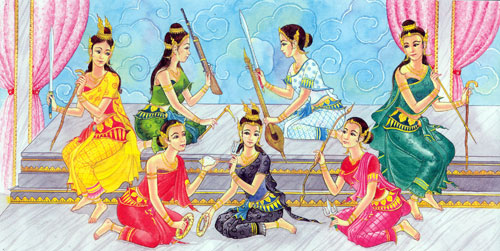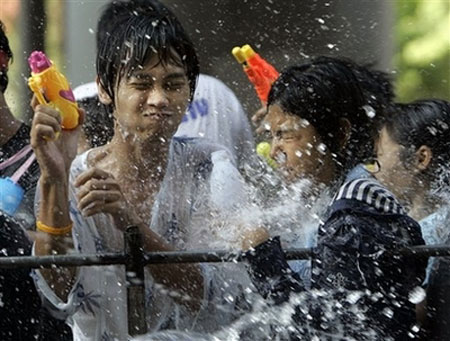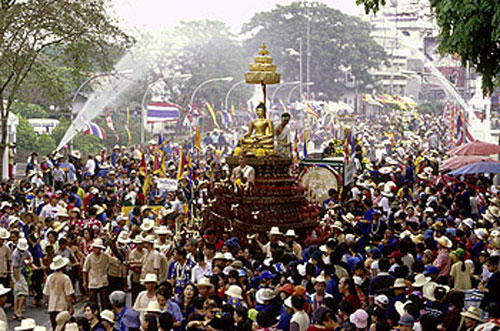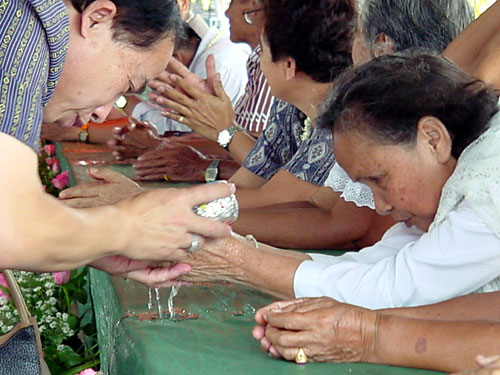|
As I was writing this article, it was a New Year in many countries in Asia. It was time to celebrate the year with both a religious ceremony and the ordinary enjoyment of a family’s days together
Songkran Festival (New Year’s Festival) in Thailand is celebrated on 13-15 April every year. It is, by far, the most popular festival in Thailand for both Thai people and foreigners alike, even though in some quarters it has become a rowdy, fun-seeking, and occasionally disrespectful activity. But for most, it is a time of purification, renewal and celebration.
Many countries near Thailand also celebrate this festival: Laos, Cambodia, Myanmar (Burma) and Thai people in Yunnan of China. Sri Lanka also celebrates a similar festival called Sinhalese, and the Tamil New Year coincides with this festival. In India, the Assamese, Bengali, Oriya, Tamil, Punjabi, and Malayali New Year falls on the same dates. The same date is celebrated widely throughout the Indian subcontinent, albeit based on the astrological event of the sun beginning its northward journey.
The Songkran Myth
In Orissa, an eastern state of India, it is the New Year and it is traditionally know as Maha Visuba Sangkranti. It seems the Thai Songkran is derived from the Sanskrit word Sangkranti which means sacred changes, mostly related to the change of orientation of Sun.
According to legend, the story involves King Kabilaprom and Prince Thammaban. Born to a wealthy family, Prince Thammaban was very intelligent even so as a child. King Kabilaprom asked him three questions with the condition that if his answers were correct, King Kabilaprom was willing to sacrifice his head but if they were wrong, the Prince must do likewise. And the questions focused on the good signs of a person at each period of the day from morning to noon until the evening. To the surprise of the King, the Prince answered the questions correctly. As it was perceived, the good sign of a person in the morning is at the face, at the chest in the noon time and at the foot in the evening. So, the King then had to cut off his head as proposed. However, the King’s head was so powerful that the whole world would be on fire if the head touched the earth, and a serious drought would occur and all ocean water would dry up should it be thrown up in the sky or down in the ocean. The King had assigned his seven angel daughters to take turn carrying his head clockwise around Phra Sumane Mountain. And if Songkran Day (13th April) falls on any day that follows, that year will be honoured by that Songkran angel.

In this year, the Songkran day was Sunday, 13 April 2008. The Songkran angel is Tungsa Davi. She wears a red dress and bracelet and prefers wild fruits. She holds a discus in the right hand and a conch shell in the left hand. Behind her ear is a pomegranate flower. Her vehicle is a garuda. And there was a pageant carnival on Songkran day as well.
The prediction for the New Year is made according to that particular day of the Songkran angel. For example, if the preferred foods of the Songkran angel are nuts and sesame seeds, it is predicted that the year will be productive, prosperous and healthy. And if the preferred food is blood, the prediction would go for a bloody year with quarrels and hardship. And if “Miss Songkran” prefers to carry a weapon, it is predicted that the weather will be full of thunderstorms, and other discomforts.
The date of the festival was originally set by astrological calculation, but it is now fixed. If these days fall on a weekend, the missed days off are taken on the weekdays immediately following. Songkran falls in the hottest time of the year in Thailand, at the end of the dry season. Until 1888, the Thai New Year was the beginning of the year in Thailand; thereafter 1 April was used until 1940. 1 January is now the beginning of the year. The traditional Thai New Year has been a national holiday since then.
Songkran is without doubt the most popular of all Thai festivals and rightly so. It marks the beginning of a new astrological year and its exact dates are determined by the old lunar calendar of Siam
Traditionally, April 13 is known as “Maha Songkran Day” and marks the end of the old year, April 14 is “Wan Nao”, while April 15 is “Wan Thaloeng Sok” when the New Year begins.
Songkran Festival in Thailand
Nowadays, the emphasis is on fun and water-throwing rather than on the festival's spiritual and religious aspects, which sometimes prompts complaints from traditionalists. In recent years there have been calls to moderate the festival to lessen the many alcohol-related road accidents as well as injuries attributed to extreme behavior such as water being thrown in the faces of traveling motorcyclists.
The most obvious celebration of Songkran is the throwing of water. People roam the streets with containers of water or water guns, or post themselves at the side of roads with a garden hose and drench each other and passersby. This, however, was not always the main activity of this festival. Songkran was traditionally a time to visit and pay respects to elders, including family members, friends and neighbors.
 |
Besides the throwing of water, people celebrating Songkran may also go to a Wat (Buddhist temple-monastery) to pray and give food to the monks. They may also cleanse Buddha images in household shrines as well as Buddha images at monasteries by gently pouring water mixed with a Thai fragrance over them. It is believed that doing this will bring good luck and prosperity for the New Year. In many cities, such as Chiang Mai, the Buddha images from all of the city's important monasteries are paraded through the streets so that people can toss water at them, ritually 'bathing' the images, as they pass by on ornately decorated floats.

In northern Thailand, people may carry handfuls of sand to their neighborhood monastery in order to recompense the dirt that they have carried away on their feet during the rest of the year. The sand is then sculpted into stupa-shaped piles and decorated with colorful flags.
One of the traditional values points to the Thai family and the opportunity for family members to express their respect for their elders. Younger members of the family pour scented water on the hands of their parents, and grandparents. They may present them with gifts or tokens of their love. In return, elders wish youngsters good luck and prosperity.
In temples, elder members of the family gather to make merit, offering alms to the monks. They may help clean the temple courtyard, or perform bathing rites for Buddha images
In the past, the fun of splashing water on friends or strangers had to wait until the late afternoon when the religious duties and ceremonies were over. That is not always true today.
The Songkran Festival is an important part of the public relations campaign of the Thai tourism authority to support culture and enjoyment of people in Thailand and all over the world. It is, after all, a festival that welcomes everyone.
|
